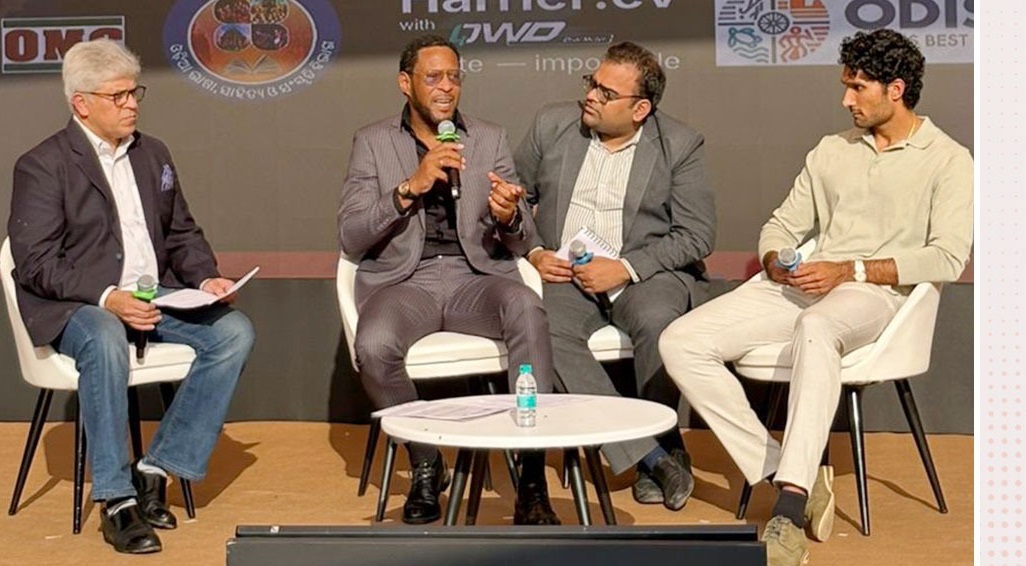New Delhi: Session 5 at the Ekamra Sports Literature Festival set the tone high—literally and metaphorically—as the world’s greatest high jumper, Javier Sotomayor, sat down for a rare, deeply reflective conversation with India’s national high jump record holder and decathlete Tejaswin Shankar. Moderated by veteran broadcaster and CEO of Network 1 Media Consultancy Pvt Ltd, Arup Ghosh, the session moved far beyond biomechanics into the intimate philosophies that define lives lived above world records.
Sotomayor—the only human ever to clear eight feet, holder of the 2.45m world record since July 27, 1993, and the owner of two earlier world records (2.43m in 1988 and 2.44m in 1989)—was welcomed with a standing ovation. Ghosh opened the session with statistics that still sound unreal: 192 jumps over 2.30m, 80 jumps over 2.35m, and 21 jumps over 2.40m. “It’s poetry in motion,” Ghosh said, recounting the grace and ease with which Sotomayor seemed to float into the air.
“The Record Was Always in My Mind Before I Jumped It”
Speaking with calm authority, Sotomayor said he visualised every world-record jump before he executed it.
“In high jump and pole vault,” he explained, “we know the exact height we must cross. It is not something accidental. The mind must get there before the body does.”
The Cuban legend revealed that his lesser-known but personally cherished record is his 2.33m Under-18 world record, which he believes will be even harder to break.
Physically, Sotomayor’s leap remains one of sport’s great marvels—biomechanists estimate 500 kg of force is loaded on his take-off ankle during the jump. “Years of training, therapy, and discipline prepared that ankle,” he said. “You cannot cheat that process.”
Tejaswin Shankar: “He Was My First Lesson in High Jump”
For Shankar—India’s national record holder and one of the country’s leading multi-event athletes—the moment was personal.
“In 2014, my coach told me to look up the world record. I typed ‘high jump world record’ into YouTube—and the first video that popped up was Javier’s 2.45m jump,” he recalled. “Before the jump even starts, he is visualising for 30 seconds with his eyes closed. That stayed with me.”
Breaking down Sotomayor’s approach run, Shankar described it as “just like a gazelle—effortlessly fast in the final steps, explosive and rhythmic in a way no one else could mimic.”
Speed, Force and the Perfect Last Step
Sotomayor revealed his technical philosophy: “There are two types of jumpers—those who rely on speed and those who rely on force. I wanted to combine both. The last step is long, explosive, and fast. That is the secret.”
He added that biomechanically, experts don’t consider his jump “perfect,” but the fusion of speed and power made it unbeatable for 31 years and counting.

The Golden Era: Why Records Fell Then, Not Now
Responding to a question from senior sports journalists, Sotomayor said the ’80s and ’90s offered an environment where clusters of elite athletes pushed each other.
“I don’t know if I could jump the same heights today,” he admitted. “The era made us.”
He compared it to the recent Barshim–Bondarenko rivalry, which briefly reignited global high jumping.
Training in Cuba vs Training in India
Shankar offered a sharp comparison of sporting cultures: “Cuba in the ’80s and ’90s didn’t have more resources than India today. But the coaching education was exceptional. A great athlete can win medals—but a great coach can produce 10 such athletes.”
Sotomayor echoed this, adding that Cuba still produces Olympic-level athletes despite limited infrastructure.
Could Better Shoes Have Taken Javier Higher?
With modern “bouncy” high-jump shoes revolutionising the sport, Sotomayor admitted:
“Both shoes today weigh what one of my shoes used to weigh.”
With better equipment and sports science, he conceded, “maybe 2.50m could have been possible.”
‘I Was Offered Money Not to Break the Record’
In a striking revelation, the world record holder said he was once offered money to avoid breaking the record.
“But I had other motivations,” he said with a smile.
The Mind Above the Bar
Summing up his philosophy, Sotomayor said: “Be passionate. Be disciplined. And every year, aim to do better than yourself. My dream was always 2.46m or 2.47m. I fell short in reality—but not in my mind.”
As the packed hall rose again to applaud, it was clear the audience had witnessed something rare: two athletes—one a global icon, the other India’s brightest modern hope—meeting at the intersection of ambition, memory, and the eternal quest to go higher.





